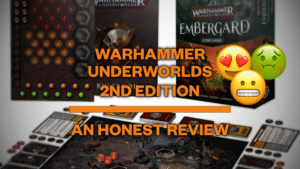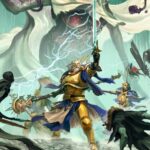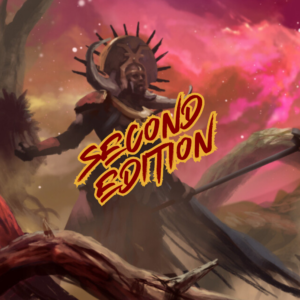
Warhammer Underworlds has always been an arena combat game, with a large focus on furious blows, smashing your enemies and charging into the fray. The draw of being able to eliminate your opponent’s models from the battlefield in an attempt to prevent them from scoring and to better your board position is a strong one. It’s always been the most luck-driven aspect of the game, drawing on pools of dice to determine the fate of the attack.
After playing some practice games in the new edition, I was left with some thoughts on the state of combat in Embergard. While the game has a lot of similarities to the original version, Strike has been updated in some interesting ways and it’s my opinion that it cannot be played in the same way as the Aggro playstyle was. I’d like to take you through those differences.
The Critical Change
A lot has already been said about the major changes to critical successes, but it’s really important to understand how these affect the game. The math making it slightly less favourable to deal damage means that your attacks have more of a chance to drive back as well, because on both sides you’ll have the one crit vs one success no longer being a pure hit or miss (without drive back). Using attacks to control your opponent’s board position, as long as they aren’t on guard, will be crucial for denial.
Overrun is a great way to keep momentum in your favour, especially without needing to make a charge. The ability to chase the enemy down is a strong one but also will potentially add support on the opponent’s other attacks. Stand Fast however is the real thing that changes the math. You can think you’ve got the kill but it could just make the enemy vulnerable. Now, I’d argue that I’d rather Stand Fast occur than deal zero damage on the attack, but its existence is part of my next thought.
One Shot, One Opportunity
There are a few things that bring me to the conclusion that the new design of the game is attempting to remove one shots (that is, in one attack dealing full damage to a fighter and taking them out of action). Stand Fast is there to edit the math for those swings, allowing the defender to reduce the damage. With the change to sources of +1 damage becoming a keyword in grievous, it also takes away damage stacking in a big way. There’s no longer the ability to stack Great Strength, Gloryseeker, and Twist the Knife, turning a 2 damage attack to a 5 damage attack. Even with all of these, it’s 3 now.
Damage and health profiles have changed significantly to make it much harder to remove models. In the base box, we’ve got only one fighter who has three damage on their weapon profiles (inspired or not). With the release of the other warscrolls and fighter cards, even fighters that may have gone to three damage on inspiration now tend to have two damage and grievous. Between that, Stormcast going up to 5 health, the small Skaven going to 3 health, it’s going to be much harder to kill fighters. Think about it this way, to kill a Stormcast with most fighters, you need at least two successful attacks and likely a source of grievous. Even Ardorn needs bonus damage and to have Stand Fast not trigger to one shot Nitch.
This is a major difference in strategy as you’ll now have to start stacking damage on fighters you want to take out of action. This concept is the main change to how you need to consider using your turns, as it will take more than one to remove a model from the field.
Bounty Hunter

Now, since it’s going to take more attacks to down an enemy, you’ve got to pick your priority targets wisely. Luckily, the bounty value on the fighters can help guide you. In the previous edition, it made no difference if you killed Mollog or the squigs, they were all worth one glory, then two glory after some rules changes. Did multiple actions and going inside a large troll’s threat range make sense for one or two glory? There’s a reason Mollog is now worth four glory on the updated warscroll. The most influential models will be rated higher from a bounty stance.
I think this is a great way to use risk/reward when it comes to having to pile up damage. If two models take the same amount of attacks to take down, there’s a potential of a larger reward for one of them. Usually that will be the fighter with the larger counter-punch, better defences or abilities. It also means that taking the easy route of downing the small fighters aren’t worth the same. And raised fighters may need to be ignored as they won’t be worth any bounty. Target priority was always important for board position. Now it’s crucial for scoring as well.
Choose Your Destiny
Having to choose between the various weapon abilities might never come up in your games, but rest assured it is something you’ll need to deal with. I think it starts in deckbuilding. Too many cards that grant cleave, ensnare, brutal or grievous can become redundant or a waste of a card slot. And even playing those cards when you have a warband with fighters who have innate abilities makes it a harder choice. Stagger is probably the weakest of the keywords, unless you’re trying to take a large fighter down chip by chip. I have a feeling Grapple, as a great way to reposition fighters, will be the reason for the attack because you want to alter board state.
The concept of having to choose between accuracy and damage is the key one here. I talked before about damage stacking and the fact that you now have to choose Cleave over Great Strength is a really hard one. Do you really need the attack to hit? Do you need it to hit with the extra damage? Or the knowledge that you’ll have the extra damage if Stand Fast triggers? It’s going to depend on your hand and some of the reasons you’re starting that attack. Is it enough to take cards that just grant one accuracy keyword? Time will tell.
Tokens of My Affection

One of the hardest things I’ve had to remember now that I’m returning to the game is that Move and Charge tokens are not at all what I’m used to. I’ll start with the easy one. Move tokens don’t prevent a second Move action, they only prevent a Charge action. So, slowly but surely getting into position is a valid late game strategy, when you have fewer fighters. No longer are you stuck by only being able to make one move. To me, this was one of the reasons I loved fast aggro in first edition. I always had range to get where I needed.
But by moving up, it prevents being charged out. If it’s battle round three and you’ve got two fighters, it’s likely better to charge the first one rather than to start moving up. That way if you charge the other fighter, you’ve now got options to further activate either fighter. If you move the first one and then charge the second, you can’t activate fighter #1 unless the opponent kills fighter #2. Making the best of the final rounds will always be a matter of ensuring that you can take as many actions as possible. Cards like Duellist really help you with positioning while you’re only able to Move or Attack, and no longer Charge.
On The Edge
There’s a slow but steady pace to the way Strike has to play in the realm of Embergard. My early conclusions is that to effectively play a Strike strategy is to figure out how and where your damage needs to go, depending on the opponent, their strategy, bounty values, and the upgrades out. At the same time, scoring consistent glory from the way you want to play, attacking and being in the enemy’s face. I find that with wanting to pile on damage you can actually gain flanks and surrounds easier, due to the way you’ll need to charge in. Just be aware of the opponent’s counterattacks against your initial fighters. All of this feels slightly less on a knife’s edge than ever, because you aren’t trading one-shots, or your failed charge won’t end with that fighter immediately dead. You’ll be able to be stuck in a bit more than in the past.
What are your thoughts on how the rules and design of the core box have changed the Strike format? Are you excited? Do you think it’s still viable as a primary glory source, or will be out-maneuvered by Take & Hold or Mastery? Let me know your thoughts. I’m on the Discords as Matt ~ Set The Tempo, or reach out to me at setthetempoblog@gmail.com. And as always, keep charging recklessly into low odds attacks!
















